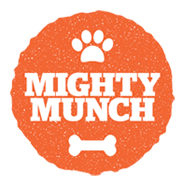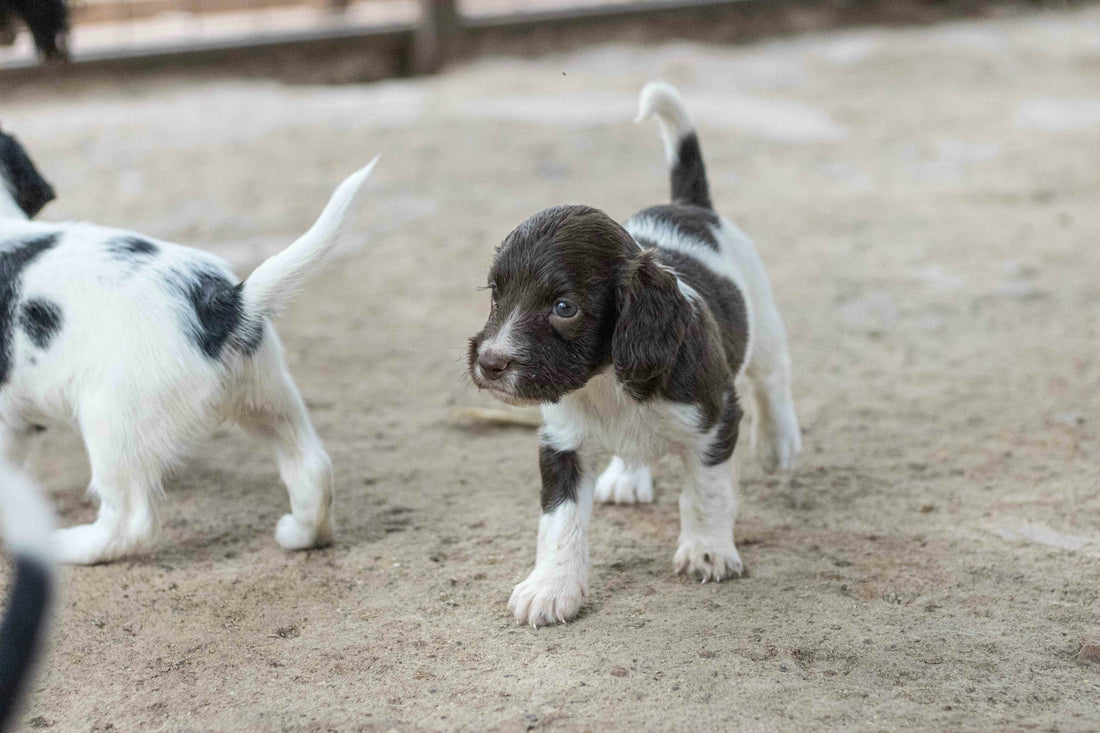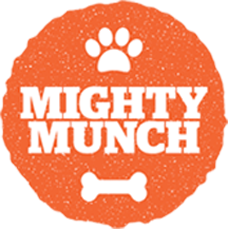Dental plaque in dogs, the sticky film of bacteria that forms on their teeth, can lead to bad breath, gum disease, and even more serious health issues if left untreated. While brushing your dog’s teeth is an effective dog dental plaque remover, most pet owners know that it’s easier said than done - most dogs are not a fan of having their teeth brushed!
Thankfully, there are many other ways to combat dental plaque and keep your pup’s teeth healthy, and some of them are a lot easier than brushing! At Mighty Munch, we have dental sticks dogs love that actually work to remove plaque and protect your dog’s long-term oral health.
Read on to learn how to get rid of dog dental plaque, and how a Mighty Munch daily dental stick can save you potentially thousands in vet dental bills by keeping your dog’s teeth strong, clean, and healthy.
What is the Brown Stuff on My Dog’s Teeth?
If you’ve noticed brown or yellowish discolouration on your dog’s teeth, you might be wondering what it is and how to deal with it. This buildup is often a sign of poor oral hygiene and can have long-term effects on your dog’s health if you don’t invest in a dental plaque remover for dogs.
Dental Plaque vs Tartar
Dental plaque is a soft, sticky film of bacteria that forms on your dog’s teeth after eating. If not removed through regular brushing or chewing, this plaque hardens into tartar, also known as dental calculus. In terms of the stages of dental disease in dogs, plaque comes first, then tartar.
Tartar is the brown or yellow substance you see on your dog’s teeth, typically along the gumline. Plaque can be removed relatively easily with proper dental care, but once it turns into tartar, it requires professional cleaning by a vet.
Tartar not only looks unsightly but also creates a rough surface on the teeth, making it easier for more bacteria to accumulate and leading to potential issues like gum disease or tooth loss.
Common Causes of Plaque Build-Up
Several factors contribute to the formation of plaque on dog’s teeth, including diet. Dogs that eat primarily soft, wet food are more prone to plaque buildup because the food particles stick to their teeth, unlike dry kibble, which can have a mild scraping effect.
Another common cause of plaque build-up is poor dental hygiene. Without regular use of a dog dental plaque remover like tooth brushing or the use of dental chews and toys, plaque is more likely to accumulate and harden into tartar.
Breed and age also play a role - smaller dogs like Chihuahuas and toy poodles are more susceptible to dental problems due to the shape of their jaws and crowding of teeth, while older dogs are more likely to have dental plaque and tartar due to prolonged exposure to bacteria over the years.
Why Dental Plaque in Dogs is a Serious Concern
Dental plaque might seem like a minor cosmetic issue, but it can quickly escalate into more serious health problems if left unaddressed. Here’s why all pet owners need to learn how to get rid of dog dental plaque before it’s too late.
Connection Between Plaque and Periodontal Disease
Dental plaque is the first stage in the development of periodontal disease - a common but preventable condition in dogs. As plaque hardens into tartar and accumulates along the gumline, it irritates the gums and causes inflammation, known as gingivitis.
If this inflammation is not treated, it can progress to periodontal disease, where the structures supporting the teeth, such as the gums and jawbone, are damaged. Periodontal disease can lead to painful chewing and eating difficulties, and may even cause your dog’s teeth to become loose or fall out.
In more severe cases, it can lead to abscesses or infections in the mouth, which can be deadly if untreated, eventually leading to sepsis. Periodontal disease is irreversible in its advanced stages, making early prevention and treatment of dental plaque critical.
Impact on Overall Health
The effects of dental plaque aren’t limited to your dog’s mouth. When left untreated, bacteria from plaque and tartar can enter the bloodstream through inflamed gum tissue, spreading to other parts of the body.
This can lead to systemic issues, including heart problems, kidney and liver damage, and a weakened immune system. That’s why learning how to get rid of dog dental plaque is so important - it’s an essential part of your dog’s overall well-being.
Can I Remove Plaque From My Dog’s Teeth at Home?
So, let’s talk about how to get rid of dog dental plaque. Do you have to rely on professional dog dental plaque removers, or are there at-home methods you can use? Regular at-home care can save you money, reduce your dog’s stress, and play a vital role in preventing plaque buildup, but it’s important to know when professional care is needed.
Let’s take a look at the best way to keep dogs teeth clean at home, and the most effective methods for dental disease prevention for dogs.
When Professional Cleaning is Necessary
If your dog’s teeth already have a significant amount of hardened tartar (the brown or yellow crusty substance near the gumline), at-home cleaning won’t be enough. Tartar must be removed by a vet using specialised tools in a professional dental cleaning, which often requires anesthesia.
Signs that your dog may need professional cleaning include persistent bad breath, discoloured teeth with visible tartar buildup, and red, swollen, or bleeding gums. Professional cleaning is not just about removing tartar - it also includes an exam to detect and address other dental issues like cavities or infections.
In terms of how often to get dogs teeth cleaned, most vets recommend a dental cleaning every six months. However, the cost of dog dental cleaning can be high, and you can save some money by reducing the frequency to once per year, which is fine if you’re taking good care of your dog’s teeth at home.
Saving Money and Stress With Regular At-Home Cleanings
Regular at-home care can help prevent dental plaque in dogs from hardening into tartar, reducing the need for costly professional cleanings. Brushing your dog’s teeth with toothpaste is one of the best things you can do, if your pup will let you!
Make sure you use a dog-specific toothpaste, as many human toothpastes contain ingredients that are harmful to dogs. You can also complement regular brushings with other at-home dog dental plaque removers like flossing and dental chews to make them more effective.
The Importance of Consistency in Canine Oral Care
Consistency is the key to keeping your dog’s teeth healthy. Irregular or sporadic efforts won’t effectively control plaque buildup, and small issues can quickly grow into larger problems. Establishing a daily or weekly routine for dental care ensures long-term benefits.
So, how often should you brush your dog’s teeth? Aim for 2-3 times per week, and try to keep your timing consistent so your dog gets used to the experience. Whether you’re brushing dogs teeth vs dental chews, or using dental chews vs floss, consistency is really important.
How to Get Rid of Dog Dental Plaque: Home Remedies and the Best Dog Dental Plaque Remover
Learning how to get rid of dog dental plaque at home is easier than you might think. From regular brushing to making dietary changes, here’s how to remove dog dental plaque and keep your pup’s teeth strong and healthy.
Brushing Your Dog’s Teeth
As we mentioned, brushing your dog’s teeth is one of the most effective ways to remove dental plaque in dogs and prevent tartar. Use a dog-specific toothbrush and toothpaste, start slowly, and focus on areas where plaque tends to build up, like the gum line. If you’re wondering how to whiten dogs teeth, start with brushing!
Dental Chews and Toys
Are dental chews good for dogs teeth, or are dental sticks bad for dogs? Actually, they’re a very effective dog dental plaque remover! How do dog dental sticks work, and what do dental chews do for dogs? As your dog chews, the stick breaks down and scrubs plaque and tartar from your dog’s teeth.
You can make DIY dog dental chews, but why go to all that effort when we’ve already perfected the formula for you?! Mighty Munch dental sticks contain key ingredients (and are infused with a potent dog probiotic) that freshen breath, strip plaque and tartar, and fight bad bacteria.
When can you give puppies dental chews? Mighty Munch chews are safe for all breeds and ages, but it’s best to wait until your pup is 6 months old before you start using dental chews. Our chews come in two sizes, and you can also learn how to soften dog dental chews to make them more manageable for smaller mouths.
How many dental chews can a dog have a day? Just one dental chew a day is an effective dental plaque remover for dogs, and can freshen your pup’s breath and whiten their teeth.
While you’re here, make sure you check out the rest of our Australian dog supplements. All Mighty Munch supplements are manufactured in Australia, backed by vets, and exceed the country’s pet safety standards. We have joint supplements, fish oil, and the best dog probiotics Australia has to offer!
Natural Plaque-Removing Solutions
Natural remedies can be a gentle way to manage plaque. For example, rubbing a small amount of coconut oil on your dog’s teeth can help reduce bacteria and freshen breath, and adding a teaspoon of apple cider vinegar to your dog’s water bowl to combat plaque and bacteria.
Are carrots good for dogs teeth? Absolutely - crunchy snacks like carrots and apples act as natural teeth cleaners while being healthy treats. Always introduce natural remedies gradually and monitor your dog’s reaction.
Dog Dental Powders or Water Additives
Dental powders and water additives are convenient options for maintaining oral hygiene, but are they really that effective? Does dog dental powder work? Powder sprinkled on your dog’s food can remove some plaque, but it’s not as effective as dental chews or brushing.
Do dental water additives for dogs work? It’s easy to mix a few drops of water additive into your dog’s drinking water, and it will freshen their breath, but because there’s no mechanical action or scrubbing involved, it’s not the most effective dental plaque remover for dogs.
Regular Vet Visits
Even with diligent home care, regular vet visits are crucial for monitoring and maintaining your dog’s dental health. Your vet can conduct professional cleanings to remove tartar and address underlying issues, detect early signs of dental disease, and give you tailored advice for your dog’s specific needs.
Dietary Adjustments to Prevent Plaque Build-up in the First Place
Wondering how to remove dog dental plaque by changing your pup’s diet? Shifting to a high-quality diet with crunchy kibble that helps scrape plaque from teeth is a good start. It’s also important to avoid sugary or sticky treats that contribute to plaque buildup.
Harder, more abrasive foods are generally best, but if your dog is recovering from oral work, you might need to stick to the best soft foods for dogs after dental surgery until your pup has healed. Are bones good for dogs teeth? In certain scenarios, yes, as long as you’re using the right types of bones and supervising your dog as they chew.
Final Words on How to Remove Dog Dental Plaque
If you don’t treat plaque buildup, your dog may suffer from painful dental issues and potentially life-threatening health complications. Luckily, learning how to remove dog dental plaque isn’t complicated, and for the most part, can be done at home.
Dog dental chews are one of the most effective solutions for removing plaque from your dog’s teeth. With every gnaw, your dog scrubs plaque from their teeth, preventing periodontal disease and other long-term dental problems.
At Mighty Munch, you’ll find the best dental chews for dogs, formulated from natural ingredients without harmful fillers or unnecessary additives. Your pup will love chewing away on their Mighty Munch dental stick, and you’ll love the fresher breath, cleaner teeth, and improved oral hygiene!
Get the best dental plaque remover for dogs - switch to Mighty Munch today and protect your dog’s oral health.


